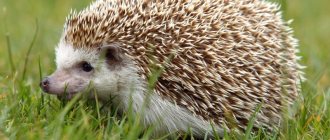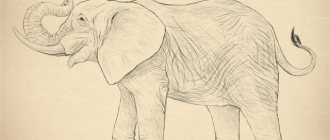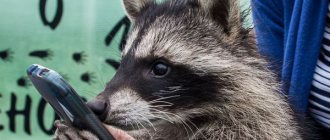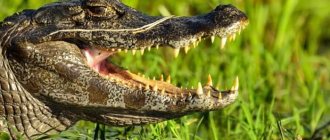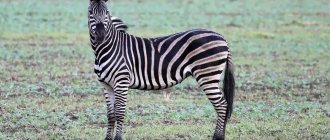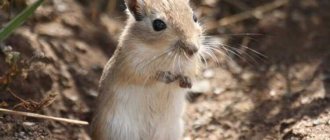Giant pandas or bamboo bears, the only representatives of their genus, are mammals from the bear family. They are easily recognized by their peculiar black and white coat color. In the middle of the last century, pandas became a national emblem in China. And the Chinese name of the species literally translates as “cat bear”.
Giant pandas first became known in the 19th century thanks to the missionary Armand David from France. They quickly became a favorite among the public due to their resemblance to teddy bears. In addition, the innocent image of a living soft toy is due to the fact that giant pandas are vegetarians and eat mainly bamboo.
Description of the panda
— Advertising —
Panda photo and description
The body length of the giant panda is in the range of 1.2-1.8 m, weight is 17-160 kg. Males are larger than females in these indicators. Pandas are distinguished from other types of bears by their rather long tail, the length of which is 10-15 cm. The body is massive. The fur is thick, white, the eye circles are black, as well as the ears and paws are black. The hind legs are full, short, with sharp claws. On the soles and at the base of each of the animal's toes there are well-developed bare pads that help the panda support itself on the smooth bamboo stems.
The giant panda is distinguished by unusual front paws, on which there is a “thumb”, as well as five ordinary fingers. The “thumb” is a modified sesamoid bone of the wrist that helps hold the thin shoots of bamboo. The same anatomical feature is characteristic of small pandas, although this species belongs to a different family.
"Brilliant Foxes" in Moscow
Red pandas were brought to the Moscow Zoo in 2009 from Madrid; a couple of animals were quite old - 10 years old. They were settled on the Island of Animals, where they settled in well: during the day they slept on the branches, and at dusk they went down to walk around the enclosure. However, after 4 years they grew old and died.
Further, in 2014, a 1.5-year-old female panda, Zane, was brought in and placed in the Old Territory, where a special enclosure with climbing structures was prepared for her arrival. She liked the stairs and logs, but not so much the house. Zein's diet is based on mixed feed made from chopped fruits and green bamboo shoots.
In 2015, she was finally lucky enough to find a mate: a male was brought from a Polish zoo and placed in her enclosure. Since January 2022, the Moscow Zoo website has made it possible to observe online the lives of some animals in enclosures, including the family of “fire foxes.”
Panda nutritional features
Panda eating bamboo photo
– Advertisement –
Around 13:00 every day, the giant panda searches for food. The diet of this animal consists mainly of young bamboo shoots, and if they cannot be found, the panda is content with old stems. The animal's strong, powerful teeth help it cope with tough bamboo. Since bamboo does not contain many calories, the giant panda chews it almost all the time. During the day, an average-sized adult eats approximately 25-30 kg of bamboo.
For a long time it was believed that bamboo was the only food for giant pandas. But bones were found in the stomachs of dead animals, from which we can conclude that the diet is predatory; sometimes pandas include carrion in their diet. If serious problems arise with the availability of bamboo, animals can switch to feeding on vines, bark, leaves, tree stems, and plant roots.
Diet
Giant pandas have a strict energy reserve. They move little and, as a rule, obtain food while moving. Giant pandas can spend 10-12 hours a day eating. Bamboo is the pandas' main source of nutrition, but the animal only gets about 17% of its nutrients from the leaves and stems. Giant pandas are well known for their upright feeding posture, which allows their front legs to freely handle bamboo stalks. An extra finger on a panda's hand helps it tear bamboo. The walls of the panda's stomach are extremely muscular, thanks to which woody food is digested, and the intestines are covered with a thick layer of mucus, which protects against splinters. Their diet consists of: bamboo stems and shoots, fruits, plants, small mammals, fish and insects.
Panda distribution
Areas on the map where pandas live
Giant pandas are found in the mountains of Central China (Sichuan and Tibet). Bamboo forests, dense thickets of which are located in this region, as well as on the islands of Kalimantan and Indonesia, are ideal for the life of this species. Here the animals do not have a shortage of food, and they can easily hide and lead their quiet lifestyle, hidden from prying eyes.
Habitat
Where do pandas live? The animals' natural habitat is dense bamboo thickets in the countries of Far Asia. In winter, they go into semi-hibernation.
Buying such a pet for home or a zoo is not easy, since cute bears are very expensive and a lot of paperwork is also required. In addition, they are included in the Red Book lists.Common panda subspecies
For the giant panda, there are two subspecies:
- Ailuropoda melanoleuca melanoleuca is an inhabitant of Sichuan province, which is characterized by a typical black and white coloration.
Black and white panda photo
- Ailuropoda melanoleuca qinlingensis - found in the Qinling Mountains, Shaanxi Province, at an altitude of 1300 to 3000 m above sea level. It differs from the nominate subspecies in its smaller size, brown and light brown color (instead of black) of the dark areas of the body. This population was discovered in the middle of the last century, but was described as an independent subspecies only at the beginning of the 21st century.
Photo of a brown panda
Panda behavior
Panda lies on a branch photo
Although the giant panda belongs to the order of carnivores, it actually feeds exclusively on bamboo. An adult needs about 30 kg of shoots of this plant per day. To protect the esophagus and stomach from bamboo slivers, it is lined with a thick layer of elastic mucous tissue. In zoos, giant pandas are fed special “cookies” made from pressed bamboo fibers. But in general, giant pandas are omnivores. They can feed on eggs, small birds and animals, some insects, and even carrion if they cannot find enough bamboo. In addition, food of animal origin serves as a source of protein. However, if a giant panda does not receive bamboo in its diet at all, it will quickly die.
Males of this species live in wider territories than females. For life, they prefer high-mountain forests located on steep slopes, which provide good shelter for the birth of cubs in bamboo thickets. In the summer, giant pandas move to altitudes of up to 4,000 meters above sea level to avoid high temperatures.
Giant pandas are active all year round; hibernation is not typical for this species. These animals are very calm and lead a secretive, peaceful lifestyle.
Name and its origin
The history of the discovery and naming of the red panda goes back to the 13th century, when the animal was first mentioned in ancient Chinese scrolls from the Chow Dynasty. Only by the 19th century did information about it become known in Europe. The English army general and naturalist Thomas Hardwicke managed to discover and describe the red panda in 1821 in the mountains of northern India, who presented his report on it to the Linnean Society in London. According to his reports, the Chinese and Nepalese called the animal “punya” (poonya), but he suggested giving it a name based on the characteristic sounds that it produced - “wa”.
Almost simultaneously with Hardwick, a description of the animal was made by the French scientist Fr. Cuvier, who found it very cute, for which he gave it the name “brilliant cat” (Ailurus fulgens). Gradually the name "punya" was anglicized and transformed into "panda".
Panda breeding
Photo of a panda family
Sexual maturity in giant pandas occurs at the age of 4-8 years. The mating season begins in mid-March and ends in May. At other times, animals lead a solitary lifestyle. The duration of pregnancy is 95-160 days. 1-2 babies are born, weighing from 90 to 130 grams, covered with thin fur. If there are two cubs in the litter, then the female will only care for the first of them and abandon the second. The female gives birth once every two years. Slow reproduction slows down the species' population growth, allowing giant pandas to avoid competition for food.
Until 2000, giant pandas were not able to reproduce in captivity. And now this phenomenon is very rare.
Natural enemies of pandas
Photo of a panda eating
The giant panda is a vulnerable species. Until 2016, it was an endangered species, characterized by a constantly declining population size, as well as a low birth rate, both in the wild and in captivity. The population size of the species in the wild is just over 2,000 individuals. Recently, the number of animals has been gradually increasing, and therefore the status of the species has also changed.
Life in captivity
Modern zoos around the world (in some cities in China and Sweden, as well as in Warsaw (Poland), Dublin (Ireland), Berlin (Germany), etc.) contain more than 800 red pandas. In Russia there lives 1 couple in Moscow, one animal each in St. Petersburg and Novosibirsk.
Keeping them in captivity is not at all difficult, because thanks to their love for trees, they don’t even need spacious enclosures. Most often they are housed in pens fenced with metal mesh or plexiglass, with tall trees and scatterings of boulders and logs located inside.
The nature of the animals is quite peaceful, so they are kept in groups of several individuals in each enclosure (usually 1 male and 2 females). They can also be housed together with other larger and more peaceful animals, such as deer. Red pandas breed freely in captivity: more than half of the zoo animals were born in the same conditions.
Interesting facts about the panda:
Logo of the World Wildlife Fund (WWF)
- According to unofficial data, the cost of a giant panda is about $10,000. But paperwork for exporting an animal from China is very complicated, and smuggling will result in a prison sentence of five years or more.
- In China, killing a giant panda is punishable by death.
- The giant panda is the symbol of the World Wildlife Fund (WWF).
- One of the manifestations of cultural exchange between China and the Western world was the rental of giant pandas by zoos in the USA and Japan. The giant panda was first given to Japan as a diplomatic gift by Empress Wu Zetian. Since the late 20th century, the Chinese government has leased giant pandas for 10 years. According to the standard lease terms, the rent is $1,000,000 per year, and includes a guarantee that all cubs born during this time will be the property of China.
- In the early 21st century, the Chinese government offered Taiwan a pair of giant pandas, named Tuan-Tuan and Yuan-Yuan (translated as "reunion"), as a gift to Taiwan. But Taiwan President Chen Shui-bian refused this gift, and the pandas came to the island after the Kuomintang returned to power.
Family ties
There are several common features that make it possible to connect two different families with each other: giant and small pandas. For a long time, zoologists could not come to a common opinion about the degree of their relationship, until geneticists confirmed what the Chinese peasants knew on a subconscious level.
The small (fire fox, cat-bear, Fire Fox, red or fiery) and large (bamboo bear) pandas are not related at all.
Malaya is the only representative of the panda family, the closest relatives of raccoons, mustelids, skunks, foxes, bears and even dogs.
The big one belongs to the bear family; its closest relative is the spectacled bear. Both species are not similar to each other at all, both in size and color.
But what unites them? There are several signs, and only by them can we somehow unite these cute little animals into a single group:
Habitat. Who doesn’t know in which country the bamboo bear and the bear fox live? Of course, in China. And only in certain provinces.
Nutrition. Despite the fact that both families are predators, their main diet is bamboo. Animals eat it in huge quantities; the rest of the “supplements”—plant and animal food, and even sometimes carrion—make up only 1% of the diet for bamboo bears and up to 5% for fox bears. For variety and in the absence of bamboo in the required quantity, bird eggs, small animals, berries, mushrooms, and various fruits are added to the mono-diet. Bamboo is very difficult to digest (up to 20-25% of what is eaten), since the structure of the stomach of these animals does not have the features characteristic of herbivores. It is short, has no chambers, and in general, the structure of the gastrointestinal tract is typical for carnivores.
The lifestyle is significantly different, but when eating, a common habit is noted: the animals prefer to eat bamboo, sitting comfortably on the ground.
"Sixth finger" In fact, it is simply a process of the sesamoid bone of the wrist, the so-called “false” finger, which is opposed to the rest.
Interesting to know: scientists believe that the appearance of a false finger in both species is not related to the relationship of the animals. This is an independent result of evolution related to nutrition: the bone process developed as a result of eating bamboo, which is known to be quite tough and durable.
This is where the similarities end. At the genetic level, both families are different, and in appearance they are absolutely not alike. True, they have one common problem - too small a population has survived to this day. The animals are on the verge of extinction due to poor fertility, destruction of natural habitats, and periodic simultaneous death of bamboo thickets. And, naturally, because of people’s desire to show off the valuable fur of these animals. Extermination has brought both species to the brink of survival; they are listed in the Red Book as endangered and critically endangered species.
Important: at the moment in China, killing even one panda is punishable by death. The measure is tough, but, according to the authorities of the Celestial Empire, necessary.



